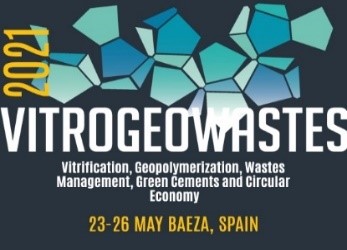Conferences
23–26 May 2021, Baeza, Spain
2nd workshop-symposium vitrogeowastes: Vitrification, Geopolymerization, Wastes Management, Green Cements and Circular Economy

The Conference about VitroGeoWastes will take place in a beauty location in Southern Spain called Baeza. One of the main tasks to be addressed today by the scientific-technical community in the field of materials is the resolution of one of the energy and environmental problems caused by the massive production of Portland cement. The search for new alternative or green cements is necessary to limit the emissions of CO2. The most promising green cement is alkaline cement or geopolymeric cement due to its properties and low environmental impact, being considered the cement of the future. One of the advantages of geopolymers with respect to traditional cements and ceramic materials from an environmental perspective is largely associated with CO2 emissions, since in the geopolymer manufacturing process the emissions are much lower. This is mainly due to the absence of the high temperature calcination stage in the synthesis process.
Alkaline activated materials (AAM), inorganic polymers or geopolymers constitute a new class of synthetic inorganic polymeric materials generated by alkaline activation of aluminosilicates characterized by a mainly amorphous three-dimensional network structure. These materials can be used in multiple applications: cementitious material, catalytic support and even as a reinforcing matrix for composite materials with fibers.
In the frame of a widespread and ever-increasing emphasis on sustainability, AAM have attracted attention among researchers because are materials that can be obtained from different precursors rich in Si-Al minerals, including waste and industrial by-products, with a low temperature production process, therefore implying great environmental benefits compared with traditional cementing materials due to the ongoing emphasis on sustainability.
In addition to this, it will be reviewed and discussed the main structural and microstructure aspects of glasses, glass-ceramics and geopolymers obtained from both processes of vitrification and geopolymerization of all types of industrial wastes for best characterization for best knowledge and improving of final properties.
Another topics covered will be basic principles for immobilization of wastes by sintering (ceramization), characterization of ceramic materials made by recycling of wastes, fundamentals of vitrification process for immobilization of wastes and subsequent crystallization and their full characterization and fundamentals of geopolymerization of wastes for their immobilization and characterization (microstructure and technological properties). The workshop sessions will include lectures on management and reuse of waste and industrial by-products applied to obtaining new ceramic materials cements and glass ceramics, as well as the importance of these aspects in the so-called Circular Economy.
Conference Website: http://vitrogeowastes.com/
http://vitrogeowastes.com/wp-content/uploads/2021/02/Tryptic-Vitrogeowastes-2021-v2.pdf




